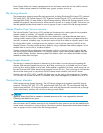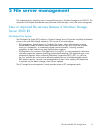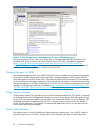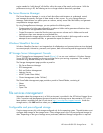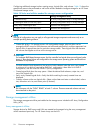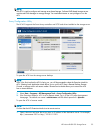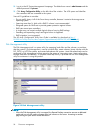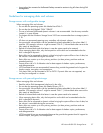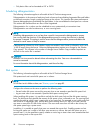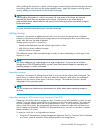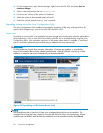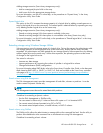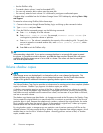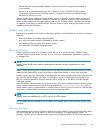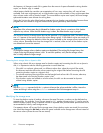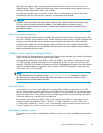
• Only basic disks can be formatted as FAT or FAT32.
Scheduling defragmentation
The following information applies to all models of the HP ProLiant storage server.
Defragmentation is the process of analyzing local volumes and consolidating fragmented files and folders
so that each occupies a single, contiguous space on the volume. This improves file system performance.
Because defragmentation consolidates files and folders, it also consolidates the free space on a volume.
This reduces the likelihood that new files will be fragmented.
Defragmentation for a volume can be scheduled to occur automatically at convenient times.
Defragmentation can also be done once, or on a recurring basis.
NOTE:
Scheduling d
efragmentation to run no later than a specific time prevents the defragmentation process
from runnin
g later than that time. If the defragmentation process is running when the time is reached,
the pr oces
s is stopped. This setting is useful to ensure that the defragmentation process ends bef ore the
demand for
server access is likely to increase.
If defragmenting volumes on which shadow copies are enabled, use a cluster (or allocation unit) size of
16 KB or larger during the format. Otherwise defragmentation registers as a change by the Shadow
Copy process. This increase in the number of changes forces Shadow Copy to delete snapshots as
the limit for the cache file is reached.
CAUTION:
Allocation unit size cannot be altered without reformatting the drive. Data on a reformatted drive
cannot be recovered.
For more information about disk defragmentation, read the online help.
Disk quo
tas
The following information applies to all models of the HP ProLiant Storage Server.
Disk quo
tas track and control disk space use in volumes.
NOTE:
Tolimitthesizeofafolderorshare,see"Directory quotas"onpage82.
Configure the volumes on the server to perform the following tasks:
• Prevent further disk space use and log an event when a user exceeds a specified disk space limit.
• Log an event when a user exceeds a specified disk space warning level.
When enabling d isk quotas, it is possible to set both the disk quota lim it and the disk quota warning
level. The disk quota limit specifies the amount of disk space a user is allowed to use. The warning level
specifies the point at which a user is nearing his or her quota limit. For example, a user’s disk quota limit
can be set to 50 megabytes (MB), and the disk quota warning level to 45 MB. In this case, the user
can store no more than 50 MB on the volume. If the user stores more than 45 MB on the volume, the
disk quota system logs a system event.
In addition, it is possible to specify that users can exceed their quota limit. Enabling quotas and not
limiting disk space use is useful to still allow users access to a volume, but track disk space use on a
per-user basis. It is also possible to specify whether or not to log an event when users exceed either their
quota warning level or their quota limit.
58
File server management



